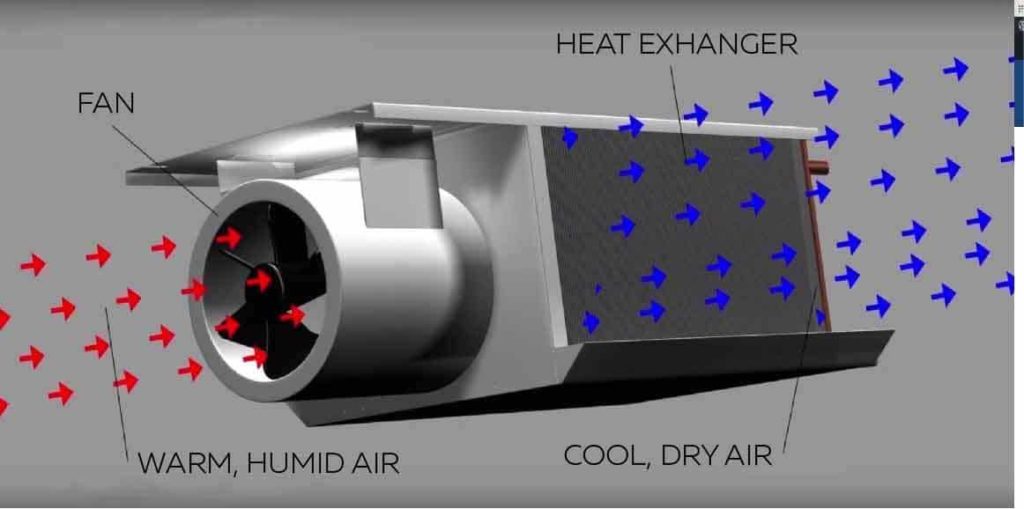What is Hydronic Cooling and Why Should I Care?

Hydronic cooling is ideal for creating precise cultivation environments.
Choosing the right climate control system for an indoor cultivation facility is a big decision as it is usually the single largest capital expenditure a cultivator will make besides real estate (and sometimes not even that). More importantly, the success of a cultivation operation depends greatly on cultivators’ ability to create the ideal environment for cannabis to grow.
While there are many options, our years of expertise have taught us that hydronic systems have the most benefits for climate management in cultivation facilities. However, many people in the industry are still unfamiliar with this technology. To better explain why hydronic systems are ideal, we’re going to delve into the science behind hydronic cooling.
The first thing to understand is that an area is not cooled by introducing cool air but rather, by removing the heat. Hydronic cooling is simply the removal of heat from the space utilizing chilled water as the heat exchange medium. As opposed to evaporative cooling which introduces humidity into the space, hydronic cooling is completely closed loop meaning no water is added to the space for the purpose of cooling. In hydronic cooling, water is chilled by a chiller, dry cooler, or cooling tower and circulated via pump through the system into heat exchanger units (air handlers or fan coils) and then back to the chiller. Air handler and fan coil units utilize a fan to pull warm air in and over the heat exchanger inside. As warm air in the room moves over the heat exchangers, heat is transferred from the air into the cool water inside the coils, pulling heat and humidity from the room and returning cool, dry air to the space. Since pumps keep water inside the system constantly moving, the warm water leaving the heat exchanger is immediately returned to a chiller, dry cooler or cooling tower. These units sit outside the facility, allowing them to reject the heat absorbed from the room into the air outside.
Hydronic cooling has been used in a multitude of applications due to its many benefits. In particular, hydronic systems are ideal for process cooling, which refers to removing heat created by a process (such as cultivation) rather than by ambient temperatures outside (like residential air conditioning). It’s also used very commonly in applications where climate control is critical to an operation, or where multiple spaces might need to be maintained at different temperatures utilizing a single system.
Hydronic cooling is ideal for creating precise cultivation environments for several reasons:
Efficiency
Because the compressors outside don’t care about room temperature, and engage only when water temperatures exceed the set points, the chillers will not turn on every time the room needs cooling. Also, waters high heat capacity allows for fewer on/off cycles for the compressor, and the ability to daisy chain multiple compressors across a facility (without sharing air between rooms) allows the individual chillers to stage only on an as-needed basis. This is important because compressors are the most energy-intensive aspect of any climate control system; so, any system which allows compressors to only run when absolutely necessary means energy and cost savings.
Dehumidification energy consumption is another important area to look for savings. This consumption can be just as significant as the energy consumption related to cooling. Often, the electrical infrastructure related to stand alone dehumidification is substantial. However, a chilled water system’s easy manipulation of water temperatures and fan speeds can result in less energy consumption related to dehumidification.
Finally, a chilled water system allows facilities to collect condensate produced. This water can then be easily reused for irrigation of plants, helping facilities conserve water and offering further savings.
Control
A major issue facilities have with climate control is uneven zones within the cultivation space. However, by using chillers which are tied to multiple ductless fan coils distributed throughout the space, cultivators can achieve a more homogenous air temperature without duct work, ensuring all plants are treated equally.
Redundancy
Depending on the type of hydronic cooling system, cultivators can utilize a bank of chillers that all work together to cool water. In these cases, no chiller is tied to a specific room or a specific fan coil. This means that if there is a mechanical failure (or a chiller needs to be shut down for maintenance), cultivation areas won’t lose cooling. Other chillers in the bank will continue to service fan coils, ensuring no surprises or emergencies.
To achieve easy n+1 redundancy, cultivators can simply place an additional chiller on the chiller bank or slightly oversize existing units. To compare, the only way to duplicate that level of redundancy with a typical HVAC system is to put two units everywhere you need one, which is neither feasible nor affordable.
Sealed Environments
Hydronic cooling systems by their very nature allow for cultivation areas to be sealed. This is because these systems use water as opposed to air, eliminating the need to bring in any outdoor air or share air between rooms. These systems simply recycle air within the room, allowing for each individual cultivation space to be totally independent not only from the outside but also from one another. The ability to seal spaces is critical to dramatically reducing the odds of a pest or disease outbreak because it minimizes exposure to contaminants. And, if such an outbreak did occur, isolating those rooms makes it easy to contain issues to a single zone, giving cultivators a measure of confidence.
Hydronic cooling systems truly are the best option for indoor cannabis cultivation facilities due to their many benefits. At Surna, our years of experience and expertise in cannabis cultivation helps us provide the most precise cultivation environments available.
To learn more about how we can help you design the ideal facility, contact us today or request a quote.
by: Celia Daly Surna, Inc.
